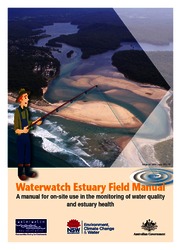Waterwatch Estuary Field Manual
A manual for on-site use in the monitoring of water quality and estuary health.
This Waterwatch Estuary Field Manual and the Waterwatch Estuary Guide have been designed to accompany the Waterwatch f eld manuals and guides for monitoring freshwater waterways. The two estuary documents contain specif c information and activities required to monitor in estuaries. They have been designed to provide information and sampling techniques for all ages, as a guide to designing and implementing a Waterwatch estuary monitoring program within schools and the community.
The methods and procedures described combine best practice and scientific rigour with straight-forward instructions, to ensure participants gain maximum benef t while also contributing high quality data to the Waterwatch database. Such data becomes a valuable tool for natural resource managers to use in catchment planning.
Download the complete Waterwatch Estuary Field Manual or individual chapters.
Contents
Acknowledgements, How to use this manual (PDF 532KB)
Section 1: Assessing your site (PDF 917KB)
1.1 Identifying and mapping your estuary
1.2 Draw a bird’s eye view map of your estuary work sheet
1.3 Estuary site checklist
1.4 Site observation checklist
1.5 Assessing the condition of the foreshore
1.6 Assessing foreshore activities
2.1 Safety at the estuary
2.2 Equipment for testing and sampling
2.3 Monitoring water quality in estuaries
Section 3: Interpreting your results (PDF 427KB)
3.1 Water quality guidelines
3.2 Junior estuary field result sheet
3.3 Senior estuary field result sheet
3.4 Continuous estuary result sheet – one site over time
3.5 Water colour chart
Section 4: Investigating habitats (PDF 804KB)
4.1 Essential skills: photopoints
4.2 Essential skills: transects
4.3 Essential skills: quadrats
Section 5: Habitat zones within estuaries (PDF 2.5MB)
5.1 The two main habitat zones found in estuaries
5.2 Riparian vegetation
5.3 Intertidal habitats: mangroves
5.4 Key to common mangrove species
5.5 Mangrove identif cation chart
5.6 Field identification guide: common mangrove species
5.7 Mangrove plant study (junior students)
5.8 Mangrove plant study (senior students)
5.9 Quadrat study: counting mangrove pneumatophores
5.10 Mangrove recording sheet
5.11 Mangrove assessment
Section 6: Saltmarsh monitoring (PDF 1.4MB)
6.1 Saltmarsh communities
6.2 Saltmarsh identif cation chart
6.3 Field identification guide: common saltmarsh species
6.4 Saltmarsh quadrat survey
6.5 Saltmarsh quadrat recording sheet
6.6 Estimating saltmarsh cover
Section 7: Seagrass monitoring (PDF 3.8MB)
7.1 Seagrass identif cation chart
7.2 Field identif cation guide: common seagrass species
7.3 Anatomy of seagrass
7.4 Seagrass wrack investigation
7.5 Measuring seagrass distribution: distance to the nearest edge
7.6 Measuring seagrass continuous cover: water based monitoring groups
7.7 Seagrass perimeter measurements: water based monitoring groups
7.8 Seagrass recording sheet
Section 8: Investigating salt water invertebrates (PDF 1.5MB)
8.1 Measuring the abundance of organisms
8.2 Common invertebrates in estuaries
8.3 Salt water bug sampling: core sampling
8.4 Core sampling recording sheet
8.5 Species abundance: counting surface snails
8.6 Quadrat study: snail recording sheet
8.7 Monitoring salt water bugs in seagrass wrack
8.8 Field identif cation guide: common crab species
8.9 Crab species recording sheet
8.10 Abundance and diversity: mudf at crab hole count
8.11 Mudflat crab hole count recording sheet
8.12 Fact sheet: green shore crab (Carcinus maenas)
8.13 Observing crabs
8.14 Abundance and diversity: shell collecting
8.15 Abundance and diversity: salt water bug survey
8.16 Estuary bug recording sheet
8.17 Fish species recording sheet
Page last updated: 05 January 2016

